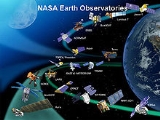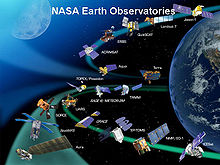
Earth Observing System
Encyclopedia
The Earth Observing System (EOS) is a program of NASA
comprising a series of artificial satellite missions and scientific instruments in Earth
orbit
designed for long-term global observations of the land surface, biosphere
, atmosphere
, and oceans of the Earth. The satellite component of the program was launched in 1997. The program is centerpiece of NASA's Earth Science Enterprise (ESE).

NASA
The National Aeronautics and Space Administration is the agency of the United States government that is responsible for the nation's civilian space program and for aeronautics and aerospace research...
comprising a series of artificial satellite missions and scientific instruments in Earth
Earth
Earth is the third planet from the Sun, and the densest and fifth-largest of the eight planets in the Solar System. It is also the largest of the Solar System's four terrestrial planets...
orbit
Orbit
In physics, an orbit is the gravitationally curved path of an object around a point in space, for example the orbit of a planet around the center of a star system, such as the Solar System...
designed for long-term global observations of the land surface, biosphere
Biosphere
The biosphere is the global sum of all ecosystems. It can also be called the zone of life on Earth, a closed and self-regulating system...
, atmosphere
Earth's atmosphere
The atmosphere of Earth is a layer of gases surrounding the planet Earth that is retained by Earth's gravity. The atmosphere protects life on Earth by absorbing ultraviolet solar radiation, warming the surface through heat retention , and reducing temperature extremes between day and night...
, and oceans of the Earth. The satellite component of the program was launched in 1997. The program is centerpiece of NASA's Earth Science Enterprise (ESE).
Mission list with launch dates

| Satellite | Launch | Agency | Date | Site |
|---|---|---|---|
| SeaWiFS SeaWiFS SeaWiFS stands for Sea-viewing Wide Field-of-view Sensor. It was the only scientific instrument on GeoEye's OrbView-2 satellite, and was a follow-on experiment to the Coastal Zone Color Scanner on Nimbus 7... |
1 August 1997 | ||
| TRMM Tropical Rainfall Measuring Mission The Tropical Rainfall Measuring Mission is a joint space mission between NASA and the Japan Aerospace Exploration Agency designed to monitor and study tropical rainfall. The term refers to both the mission itself and the satellite that the mission uses to collect data... |
27 November 1997 | Tanegashima Tanegashima Space Center The is one of Japan's space development facilities. It is located on Tanegashima, an island located 115 km south of Kyūshū. It was established in 1969 when the National Space Development Agency of Japan was formed... |
NASA NASA The National Aeronautics and Space Administration is the agency of the United States government that is responsible for the nation's civilian space program and for aeronautics and aerospace research... JAXA Japan Aerospace Exploration Agency The , or JAXA, is Japan's national aerospace agency. Through the merger of three previously independent organizations, JAXA was formed on October 1, 2003, as an Independent Administrative Institution administered by the Ministry of Education, Culture, Sports, Science and Technology and the... |
| Landsat 7 Landsat 7 Landsat 7, launched on April 15, 1999, is the latest satellite of the Landsat program. Landsat 7's primary goal is to refresh the global archive of satellite photos, providing up-to-date and cloud-free images. The Landsat Program is managed and operated by the USGS, and data from Landsat 7 is... |
15 April 1999 | Vandenberg Vandenberg Air Force Base Vandenberg Air Force Base is a United States Air Force Base, located approximately northwest of Lompoc, California. It is under the jurisdiction of the 30th Space Wing, Air Force Space Command .... |
NASA |
| QuikSCAT QuikSCAT The QuikSCAT is an earth-observing satellite that provided estimates of wind speed and direction over the oceans to National Oceanic and Atmospheric Administration and others. This "quick recovery" mission intended to replace the NASA Scatterometer , which failed in June 1997... |
19 June 1999 | Vandenberg | NASA JPL Jet Propulsion Laboratory Jet Propulsion Laboratory is a federally funded research and development center and NASA field center located in the San Gabriel Valley area of Los Angeles County, California, United States. The facility is headquartered in the city of Pasadena on the border of La Cañada Flintridge and Pasadena... |
| Terra Terra (satellite) Terra is a multi-national NASA scientific research satellite in a sun-synchronous orbit around the Earth. It is the flagship of the Earth Observing System... |
18 December 1999 | Vandenberg | multiple |
| ACRIMSAT Active Cavity Radiometer Irradiance Monitor Satellite ACRIMSAT is the acronym for Active Cavity Radiometer Irradiance Monitor Satellite. It is a dedicated satellite and instrument that is one of the 21 primary observational components of NASA's Earth Observing System program... |
20 December 1999 | Vandenberg | NASA JPL |
| NMP New Millennium program New Millennium Program is a NASA project with focus on engineering validation of new technologies for space applications. Funding for the program was eliminated from the FY2009 budget by the 110th United States Congress, effectively leading to its cancellation.The spacecraft in the New Millennium... /EO-1 |
21 November 2000 | NASA Goddard Goddard Space Flight Center The Goddard Space Flight Center is a major NASA space research laboratory established on May 1, 1959 as NASA's first space flight center. GSFC employs approximately 10,000 civil servants and contractors, and is located approximately northeast of Washington, D.C. in Greenbelt, Maryland, USA. GSFC,... |
|
| Jason 1 Jason 1 Jason-1 is a satellite oceanography mission to monitor global ocean circulation, study the ties between the ocean and the atmosphere, improve global climate forecasts and predictions, and monitor events such as El Niño and ocean eddies.... |
7 December 2001 | NASA CNES CNES The is the French government space agency . Established under President Charles de Gaulle in 1961, its headquarters are located in central Paris and it is under the supervision of the French Ministries of Defence and Research... |
|
| Meteor 3M-1/Sage III | 10 December 2001 | Baikonur Baikonur Cosmodrome The Baikonur Cosmodrome , also called Tyuratam, is the world's first and largest operational space launch facility. It is located in the desert steppe of Kazakhstan, about east of the Aral Sea, north of the Syr Darya river, near Tyuratam railway station, at 90 meters above sea level... |
|
| GRACE Gravity Recovery and Climate Experiment The Gravity Recovery And Climate Experiment , a joint mission of NASA and the German Space Agency, has been making detailed measurements of Earth's gravity field since its launch in March 2002.... |
17 March 2002 | ||
| Aqua Aqua (satellite) Aqua is a multi-national NASA scientific research satellite in orbit around the Earth, studying the precipitation, evaporation, and cycling of water. It is the second major component of the Earth Observing System preceded by Terra and followed by Aura .The name "Aqua" comes from the Latin word... |
4 May 2002 | Vandenberg | multiple |
| ADEOS II ADEOS II ADEOS II was an Earth observation satellite launched by NASDA, NASA and CNES in December 2002. Its Japanese name was Midori 2, and it was the successor to the 1996 mission ADEOS I... (Midori II) |
12 December 2002 | ||
| ICESat ICESat ICESat , part of NASA's Earth Observing System, was a satellite mission for measuring ice sheet mass balance, cloud and aerosol heights, as well as land topography and vegetation characteristics... |
12 January 2003 | Vandenberg | NASA |
| SORCE | 25 January 2003 | Cape Canaveral Cape Canaveral Cape Canaveral, from the Spanish Cabo Cañaveral, is a headland in Brevard County, Florida, United States, near the center of the state's Atlantic coast. Known as Cape Kennedy from 1963 to 1973, it lies east of Merritt Island, separated from it by the Banana River.It is part of a region known as the... |
NASA |
| Aura Aura (satellite) Aura is a multi-national NASA scientific research satellite in orbit around the Earth, studying the Earth's ozone layer, air quality and climate. It is the third major component of the Earth Observing System following on Terra and Aqua... |
16 July 2004 | Vandenberg | multiple |
| CloudSat CloudSat CloudSat is a NASA Earth observation satellite, which was launched on a Delta II rocket on 28 April 2006. It uses radar to measure the altitude and properties of clouds, adding to information on the relationship between clouds and climate in order to help resolve questions about global warming... |
28 April 2006 | Vandenberg | NASA |
| CALIPSO CALIPSO CALIPSO is a joint NASA and CNES environmental satellite, built in the Cannes Mandelieu Space Center, which was launched atop a Delta II rocket on April 28, 2006. Its name stands for Cloud-Aerosol Lidar and Infrared Pathfinder Satellite Observations... |
|||
| Hydros | June 2006 | ||
| NPOESS NPOESS The National Polar-orbiting Operational Environmental Satellite System was to be the United States' next-generation satellite system that would monitor the Earth's weather, atmosphere, oceans, land and near-space environment. NPOESS satellites were to host proven technologies and operational... |
TBD | NASA NOAA National Oceanic and Atmospheric Administration The National Oceanic and Atmospheric Administration , pronounced , like "noah", is a scientific agency within the United States Department of Commerce focused on the conditions of the oceans and the atmosphere... |
|
| OCO Orbiting Carbon Observatory The Orbiting Carbon Observatory is a NASA satellite mission intended to provide global space-based observations of atmospheric carbon dioxide . The original spacecraft was lost in a launch failure on February 24, 2009, when the payload fairing of the Taurus rocket which was carrying it failed to... |
23 February 2009 | Failed to reach orbit | NASA NOAA National Oceanic and Atmospheric Administration The National Oceanic and Atmospheric Administration , pronounced , like "noah", is a scientific agency within the United States Department of Commerce focused on the conditions of the oceans and the atmosphere... |
| Aquarius Aquarius (satellite) Aquarius is a NASA instrument aboard the Argentine SAC-D spacecraft. Its mission is to measure global sea surface salinity to better predict future climate conditions... |
10 June 2011 | Vandenberg | NASA CONAE Comisión Nacional de Actividades Espaciales Comisión Nacional de Actividades Espaciales is the civilian agency of the government of Argentina in charge of the national space program.- History :... |
| NMP New Millennium program New Millennium Program is a NASA project with focus on engineering validation of new technologies for space applications. Funding for the program was eliminated from the FY2009 budget by the 110th United States Congress, effectively leading to its cancellation.The spacecraft in the New Millennium... /EO-3 |
|||

